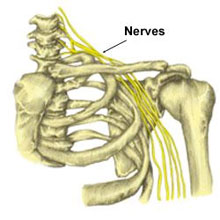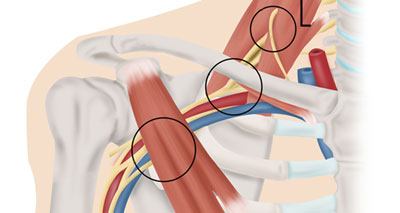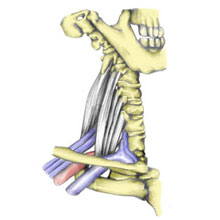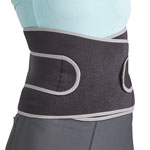Always take neck pain very seriously, especially if you also have signs of concussion or pain radiating into the shoulder and arm.
Thankfully, neck injuries are relatively rare in sports. They most often occur from activities related to daily living or work. If you spend long hours sitting in front of a computer then your risk of neck pain is higher.
When should I see a doctor about my neck pain?
Always seek urgent medical attention if you have had significant trauma to your neck or upper back. Similarly, if you have severe pain or ongoing impairment, you should also see a doctor or healthcare professional.
If you experience any of the following symptoms, seek professional medical advice from a doctor, physiotherapist, sports therapist, chiropractor, or osteopath.
- Severe neck or upper back pain
- Dizziness or a feeling of unsteadiness
- Blurred vision or altered vision
- Referred pain in the shoulders, especially if the symptoms remain after 24 hours
- Pins and needles (paresthesia) or loss of feeling (anaesthesia) in the arms or hands
Stiff neck/wry neck
A stiff neck is a common complaint which will probably affect everyone at some point in their life. It is, however, usually short-lived, lasting for just a few days at a time. Symptoms include:
- Sudden neck pain
- Stiffness
- Restricted movement, especially turning the head to the sides.
- Headache
- Pain radiating into the arms or upper back
More often than not a muscle strain causes a stiff neck. The muscle tightens up and goes into spasm to protect itself resulting in restricted movement and in some cases temporary neck deformity.
Read more on acute wry neck/stiff neck.
Whiplash
Whiplash or acceleration/deceleration injury, also known as an injury to the neck, is caused by a rapid forward and backward motion of the head. This occurs most commonly from a car accident, although can also be sustained through sports involving direct contact or a fall onto the head.
The patient will feel stiffness and pain in the neck which may not come on immediately at the time of injury but develop over the following 24 to 48 hours. They will likely have a significantly reduced range of movement in the cervical spine (neck) with headaches, dizziness, and blurred vision (this should go within 24 hours if they persist consult your doctor). The pain and stiffness can last for just a few days to a few weeks depending on severity.
Read more on Whiplash.
Neck pain with headaches
A cervicogenic headache is a headache which has resulted from a musculoskeletal neck injury or condition. Symptoms are similar to tension headaches and migraine where the patient does not have an aura or visual disturbances. If the headache is caused by neck problems then the patient will most likely have restricted movement in the neck, muscle weakness/impairments, and neck joint dysfunction.
Often work-related or postural problems can cause muscle tension in the upper back, neck, and shoulder. The muscle tension causes nerve impingement which in turn results in headaches or migraine-type symptoms.
Cervical nerve injury (radiating neck pain)
Cervical nerve injury refers to neck pain which radiates into the arm or may present as just pain in the arm, but the root cause is the neck. The patient may also experience sensory disturbances such as pins and needles and weakness in the upper arm.
Stingers and Burners

Stingers and burners are also known as brachial plexus injuries. This is a common condition in American Football and other contact sports, caused by nerve compression from impacts to the neck and shoulder area. Symptoms include a stinging or burning sensation which spreads from the shoulder, down the arm, and as far as the hand. The sensation usually lasts only seconds or a minute or two although on rare occasions it can be much longer.
Stingers and burners are caused by injury to the brachial plexus which is a group of nerves which exit the spinal cord at the base of the neck and pass down into the arm. A burning or electric shock sensation may be felt from the neck to the hand which occurs after compression or a traumatic impact to the neck.
Read more on stingers & burners.
Thoracic outlet syndrome


Thoracic outlet syndrome is a term used to describe the compression of nerves and/or blood vessels which travel from the neck to the armpit (axilla).
- Compression of these structures can cause pain, tingling, numbness, and weakness from the neck and throughout the arm.
More on Thoracic outlet syndrome
Scheuermann’s Disease
Scheuermann’s Disease is a hereditary disease that mainly affects growing boys between the ages of 13 and 16 years. It is the most common postural abnormality of the spine in young athletes. Children complain of acute pain in the upper back and in later years the upper spine (thoracic) may become hunched or rounded.
Read more on Scheuermann’s Disease.
References
- Mercer S, Bogduk N. Intra-articular inclusions of the cervical synovial joints. Br J Rheumatol 1993;32:705–10.
- Roche CJ, O’Malley M, Dorgan JC et al. A pictorial review of atlantoaxial rotatory fixation: key points for the radiologist. Clin Radiol 2001;56(12):947–58.
- Sobolewski BA, Mittiga MR, Reed JL. Atlantoaxial rotary subluxation after minor trauma. Pediatr Emerg Care 2008;24(12):852–6.

